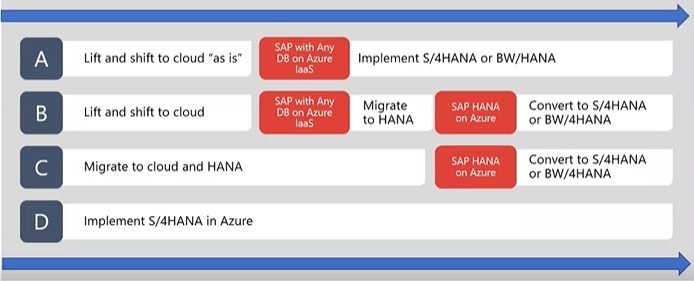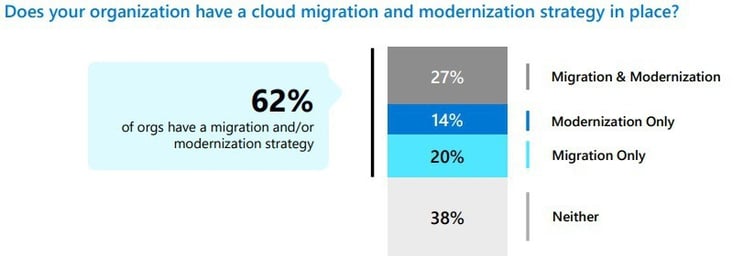SAP Cloud Migration and Modernization: Unlocking Value | Protera
The cloud has officially arrived — according to Gartner, 85% of organizations will operate using cloud-first principles by 2025 and 91% of workloads will be cloud native by the same year.
For Protera clients (and all SAP users), this has an additional element of timeliness as SAP has announced it will end maintenance for Business Suite by 2027. This means enterprises will need SAP cloud migration to migrate SAP ECC to SAP S/4HANA within the next five years, often with the help of a reliable cloud provider.
We know that the cloud is top-of-mind for our clients and enterprise organizations in every industry. As we move into 2023, many companies are asking questions like: Should we move to the cloud now or later? Should we lift-and-shift or modernize at the same time? How can we do it without disrupting business as usual?
In Protera’s recent webinar, Unlocking the Value of SAP Modern Services for Cloud Computing, my colleague (and Protera’s VP of Solutions Architecture), Adam Mommersteeg, and I explore the answers to these questions, cover the essentials of moving to the cloud, and offer insight on how to achieve maximum value from operating in a new cloud environment.
In this article — the first of a multi-part series recapping the webinar — I’ll cover these three key takeaways about cloud migration and modernization, with a special focus on migrating between SAP applications:
-
Why cloud migration ≠ modernization (and why that’s important)
-
Methods for migrating and/or modernizing
-
How the public cloud powers new levels of enterprise innovation
This article will set us up to explore additional topics covered later in the webinar, like IT and business alignment and how to implement modern workspaces on the cloud. At the end of the series, you’ll have a strong understanding of what the cloud journey entails, the best methods for your unique business, and how to leverage the cloud to deliver continuous business value.
Let’s dive in.
Data Migration ≠ Modernization
The terms cloud migration and modernization are often used interchangeably. But they’re not the same thing and it’s important for IT and business leaders to truly understand the difference before embarking on a new cloud initiative.
In short: Migration is simply moving to the cloud — it’s the first step toward modernization, but it isn’t equivalent. It means moving from legacy systems to the cloud, where your business will begin to embrace new operating models and establish new baselines related to governance, security, and continuous improvement.
In the context of SAP migration, this involves using specialized migration tools to transfer SAP ERP systems efficiently. Following best practices ensures a smooth transition, helping businesses fully leverage the capabilities of their new cloud system.
For example, a company might decide to migrate its SAP ERP system from an on-premise setup to a cloud environment provided by a trusted cloud provider. Using SAP-specific migration tools, the data and applications are transferred securely in the migration process.
By adhering to best practices such as thorough planning, testing, and data validation, the company can ensure that its SAP ERP system operates seamlessly in the cloud, enabling new efficiencies and improvements in governance and security.
Modernization is the broader scope, forward-thinking process of readying workloads, systems, and strategies for a cloud-native future. This involves leveraging SAP solutions to accelerate the transformation of business processes and optimize SAP systems.
For SAP customers, modernization means utilizing the latest SAP offerings to help ensure a clean core, enhancing efficiency and agility. Building a solid business case is crucial in this process, as it justifies the investment in modernization efforts and outlines the anticipated benefits. Using SAP to its full potential allows businesses to stay competitive and achieve continuous improvement.
So what’s the right way to cloud transformation?
For many companies, this question — to migrate first, modernize later or do both at once — is at the heart of their hesitancy to migrate to the cloud. Decision paralysis about doing it the “right” way leads to doing it no way at all. The truth, however, is that there is no single right way to get to the cloud.
At Protera, we have seen and helped customers who want to lift and shift their SAP ECC environment to a hyperscaler; and then think about modernizing to S/4HANA later on. Others have success taking the migration opportunity to transition S/4HANA and adopt the RISE with SAP methodology at the same time.

The exact path and order of operations look different for every company and depend on many factors, including their planned timeline, business urgency, and the amount of change they’re able to realistically take on at the time.
It’s important to note, too, that migrating without immediate modernization shouldn’t be seen as an inferior option. In fact, it has advantages of its own — it can eliminate immediate risk (like aging hardware or excessive IT costs), while minimizing disruption (a simple migration with SAP can take place without employees or end users even knowing it’s happened).
On the other hand, the need to migrate can serve as a much-needed motivator for leaders and stakeholders to get on board with full modernization (i.e. moving systems to the cloud and transitioning to S/4HANA and SAP Business Technology Platform at the same time, for example).
According to Microsoft research, there is a fair balance between companies taking on migration vs. modernization vs. both in 2023 — of the 62% with an immediate cloud strategy:
- 20% plan on migration only
- 14% plan on modernization only
- 27% plan to do both

Ultimately, the key to choosing the right path to the cloud is really knowing your business and its needs, capabilities, and goals for the future.
Working with a strategic partner (like Protera) can be invaluable during the decision making process — they can help you perform readiness assessments, provide system-specific expertise, and guide your migration to SAP using best-practice approaches to migration and/or modernization.
The Path to Cloud-Powered Business Success with SAP Cloud Migration
The emergence of the public cloud hosted by hyperscalers like AWS, Azure, and Google Cloud, along with comprehensive solutions like RISE with SAP, has brought new capabilities for continuous transformation, improvement, innovation, and value from cloud ecosystem, compared to traditional on-premise setups.
Like many IT professionals, my first cloud experiences in my early career were on the private cloud — we would move a workload from one private cloud environment to another one, let it run steady-state for 3-5 years, then think about our next update or transformation.
The public cloud has totally transformed this process. Today, opportunities for innovation are always changing and evolving. With cloud ERP solutions, companies can monitor their workloads for 30, 60, or 90 days after moving them to the cloud and rightsize them as needed.
They can buy reserved instances, and implement things like modern workspaces and data intelligence. SAP users can tie SAP, particularly leveraging the real-time analytics and processing power of the SAP HANA database, into cloud-native capabilities to power faster, smarter business decisions.
As companies become more sophisticated in the cloud, they can consider implementing DevSecOps, FinOps, and other hyper-collaborative strategies that can continually transform and improve the enterprise. Using a robust migration strategy, including migrating data, ensures a smooth transition and optimal performance in the new cloud environment
Innovation on the public cloud has proven to be truly endless — it’s always changing and growing — and your initial migration or modernization, will only be the beginning of reaching new value potential for your business on the cloud.
More Business Migration and Transformation Insights
The next two parts of this blog series dive deeper into two key cloud-powered advantages every business is looking to achieve today and for the future:
-
IT and Business Alignment — Integrating IT and strategic functions to maximize ROI
-
Modern Workspaces — Running productive remote work environments on the cloud
Or check out the full webinar for access to full insights on these (and other) cloud topics.
Execute Your Cloud Modernization Journey with Confidence
No matter where you are on your cloud journey, Protera’s suite of cloud modernization services allows you to take advantage of the latest cloud service enhancements. Drive down cost, improve security, and enable continuous innovation across the business with extended cloud adoption and managed services.
Learn more about Protera’s SAP Cloud Modernization services and schedule your virtual consultation session today!